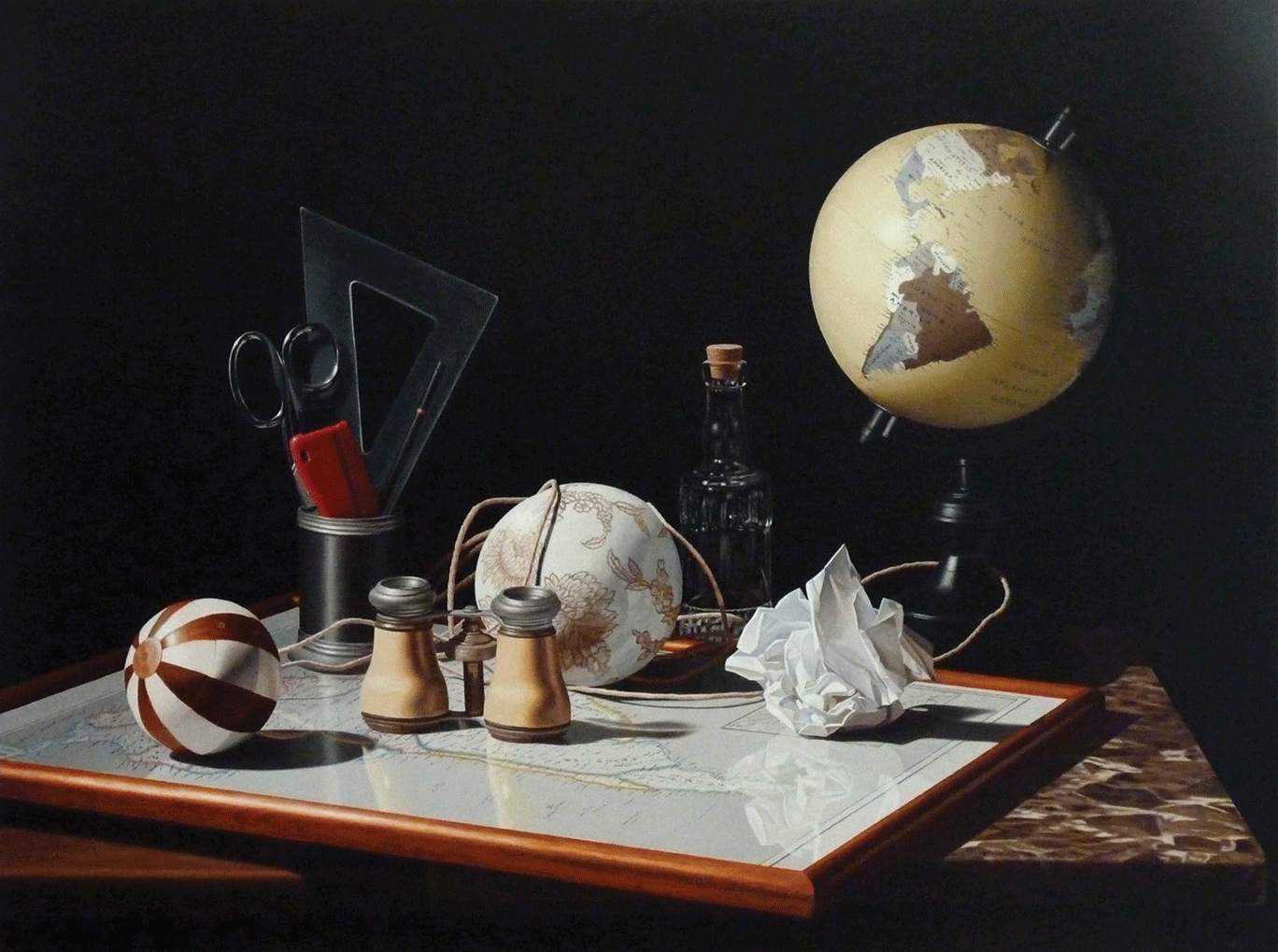« Reviews
Renato Meziat: A Decade of Realism
ArtSpace Virginia Miller Galleries - Miami
By Raisa Clavijo
Renato Meziat’s “A Decade of Realism,” an exhibition at Virginia Miller Galleries was on view until the end of March. On this occasion, the artist gathered together still lifes and scenes in which a window serves as a frame for peaceful seascapes. The exhibition reflected the unquestionable technical mastery of this self-taught creator, who learned from the pictorial legacy of the great masters, particularly Diego Velázquez.
After studying at the Berklee College of Music in Boston, Meziat returned to his native Brazil, where he became interested in painting, experimenting with brushes belonging to his father, who approached painting as a hobby.

Renato Meziat, Globe, 2014, oil on canvas, 29.6” x 39.5.” All images are courtesy of the artist and ArtSpace Virginia Miller Galleries.
The works of Meziat adhere to a naturalism that radiates light and life, unlike the tenebrous naturalism of Baroque still lifes. Each of the paintings shows his skill in reproducing the texture of surfaces, fabrics, wood, flowers, fruits and food. In them, both the inanimate objects and the characters-who occasionally appear-reveal an almost tangible realism.
Meziat carries out an obsessive study of the objects and their minute details and then painstakingly and impeccably reproduces them. He has extensively explored and experimented with tropical light and its influence on the color of objects, which varies based on the time of day. Temporality, variability and happenstance are factors to consider when analyzing the paintings assembled in this exhibition.
The origins of still-life painting date back to ancient times. Evidence remains that in Ancient Egypt they adorned the interior of the tombs of pharaohs and noblemen. Likewise, they appear in the pottery of Ancient Greece, and in the frescoes of Rome, Pompeii, Herculaneum and Boscoreale. Much later, at the end of the 16th century and chiefly during the 18th century, still lifes gained acceptance as an artistic genre. They came to satisfy the desires of consumers from the growing middle classes in countries such as Holland, the Netherlands, Spain, Italy and France. From that moment on, scenes that re-created interiors, dietary customs and daily lives no longer served merely as a backdrop for portraits and compositions with religious or historic themes, but instead became the protagonists of the work. During the Baroque, these scenes not only illustrated the lifestyle of the era, but they also implicitly carried strong symbolism, reflecting the intellectual traditions of this historic period in which religious faith found itself subverted by Protestant Reformation, scientific achievements and a rationalist philosophy. It was an epoch undermined by a preoccupation with the transience of life. Thus, scenes of bourgeois interiors in which flowers, fruit and objects of daily use are represented with masterful realism encapsulate a symbolism that alludes to the fear of the human being when faced with the fleeting nature of earthly life.
In contrast, Meziat’s work does not explicitly reflect a symbolist intention. He prefers to leave to the viewer the task of exploring the surface of his paintings and interpreting (or not) the riddle that each scene contains. “I don’t want to make people think. I want to make paintings so beautiful that when people see them they just can’t think of anything else,” he said. However, it is impossible for a human being to observe something without relating what he sees to his experiences. Inevitably, the viewer sees, feels, remembers and thinks when he confronts the work of this artist. Meziat presents and at the same time challenges the observer, subtly proposing a dialogue that will follow a path determined by intuition.
The tour of this exhibition is a unique hedonistic experience, a sensorial voyage amongst works with a moving beauty. One can almost feel the smoothness of the flower petals, the freshness of the outer coating of fruits and vegetables in contrast to the roughness of the plastic that occasionally covers them, the warmth of the fabrics, the reflections of the glass or the iridescent surfaces of ceramics. One can attempt to decipher enigmatic scenes like Globe (2014) in which a terrestrial globe, some binoculars, a world map and a glass with scissors and measuring instruments coexist on a table. In Dry Wheat (2013), some stalks of wheat lie on a wooden table next to an old weighing scale. Sunset (2017), for its part, captures a sunset through a window that opens onto the sea. In the foreground, a table appears with two lit candles and a handful of pears. Each of Meziat’s scenes reflects a moment of daily life and at the same time triggers a story that will always be different for each observer. His scenes appear to be fragments of memories frozen in time.
(November 2, 2018 - March 29, 2019)
Raisa Clavijo is the editor-in-chief of ARTPULSE. She is an art historian, critic and curator based in Miami. Clavijo has a B.A. in art history from the University of Havana and a master’s degree in museum studies from the Universidad Iberoamericana in Mexico City. Former chief curator at Museo Arocena in Mexico (2002-2006), she founded Wynwood: The Art Magazine, in Miami, where she worked as editor from 2007 to 2009. In 2009, she founded ARTPULSE and ARTDISTRICTS magazines.
Filed Under: Reviews





































[...] By Raisa Clavijo [...]